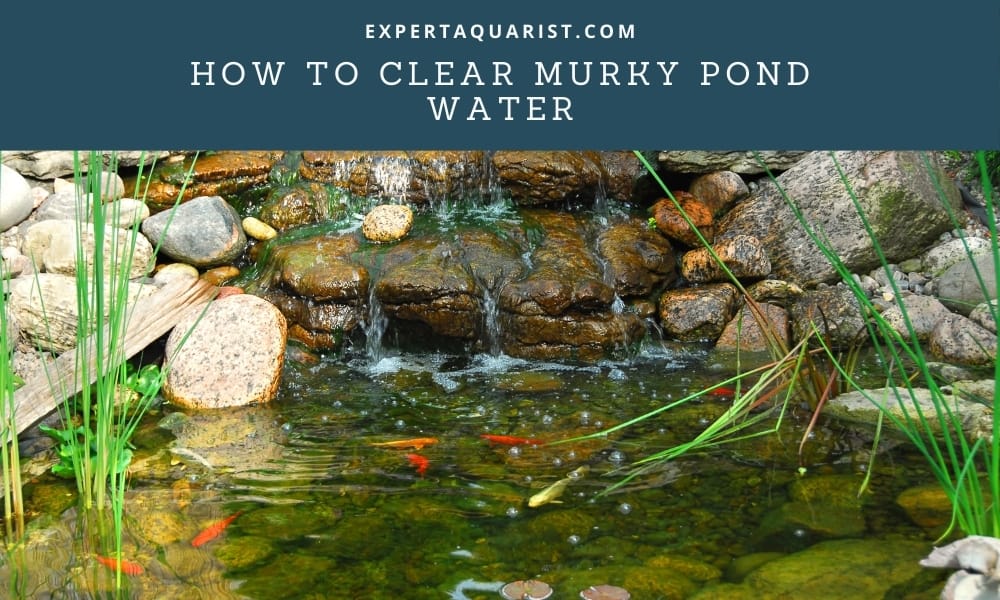It will irk any pond owner to see their pond having murky water. But many people don’t pay enough attention to the pond, and it builds up. Due to not having enough idea about how to clear murky pond water, they are sadly stuck in a rut.
It’s pretty simple to do, to get rid of the murky pond water, you have to regularly clean up your pond with a rake or a siphon and set up proper filters.
Neglecting this situation will only bring you trouble. I’m sure you want to know more about the dangers of murky water and the proper way of dealing with it, so I prepared something for you down below. Have a look!
Clearing murky water: An in-depth guide
It would have been one thing if murky water just looked unappealing, but if it is a cause of harm to various aquatic plants and fish, then it’s a different case altogether.

I gathered all the necessary methods to give you a fair breakdown of how to deal with this situation; see below:
Water quality test
 When you see murky or cloudy water, the first thing you do is take out your testing kit. You will need to check the water quality to figure out your next steps.
When you see murky or cloudy water, the first thing you do is take out your testing kit. You will need to check the water quality to figure out your next steps.
Get yourself a basic testing kit, check the pH, DO, and KH of the pond. It’s best to start with a pH test. If the pH of your pond is outside the range of 6.5-8.5, then you’re in trouble.
In newly established ponds, murkiness is pretty common when you add plants or fishes due to the sudden rise of ammonia levels. This could also happen if the filtration is improper.
Filter optimization
Waste is a big reason behind murky water in a pond. The biological filter has to break down these wastes into harmless particles. The beneficial bacteria housed in the filter has a significant part to play in this.
If the water testing kit finds out that there is an excess amount of waste accumulated in the pond, you need to review your filter as it might not be properly functioning or the filter media is clogged.
If it is working correctly, the beneficial bacteria are doing their job, and yet there is murky water, then you need to upgrade, and in case it wasn’t working properly, you need to get it fixed as fast as possible.
Slide and Debris removal
Having a bit of sludge in the pond is normal; it’s also suitable for the plants and animals but to a certain extent.
Like all things, there is a limit, and when that is exceeded, it becomes a hazard. Too much sludge causes the pond water to be cloudy.
Just like sludge, debris is also dangerous as too much debris can lead to toxicity. The best idea would be to clean up the pond regularly or have something set up in the pond that does that for you.
A net made out of strong fabric or a rake is enough to gather all of the debris, whereas you can take out sludge from the pond bottom using a siphon or a pump. Some bacteria eat sludge as well.
Algae eradication
I consider algae to be a very pestering organism in the pond; therefore, I’d advise the total removal of algae. They are one of the primary reasons for your water to be murky and bring other problems as well.
By taking proper steps at the right time, you can save yourself from many inconveniences later on that could cost you time and money.
Algae habitually stick together and make colonies survive. With a good filter and UV clarifier, you can permanently eliminate them and completely suppress future threats.
What causes murky pond water?
We already talked about how to deal with a murky pond, but it’s always best to not let such a thing occur in the first place. And for that to happen we need to know what are the causes behind it.
It’s pretty hard to tell what exactly causes your pond water to be murky, as there are quite a few nominees for that. But as a good friend, I’ve gone ahead and narrowed it down for you.
The following reasons are the most likely to cause murkiness in a pond:
1. Excessive waste
You can’t expect the water of your pond to be crystal clear when it is filled with a humongous amount of waste. If an owner isn’t paying attention, it doesn’t take too long for the waste to accumulate.
Overfeeding the fish is a common cause for this. When you give fish too much to eat, a lot of it remains uneaten; this remaining food decays with time and turns into waste.
Since many owners don’t know that they’re feeding the fish too much, they tend to neglect to check for leftovers, and we know what happens next.
Inorganic waste materials are another nuisance, and they gather in the edges of the ponds gradually that it’s very easy to overlook. When too much of it is accumulated, they make the water murky.
So, it’d be best if you always make sure to check your pond for waste, and try to figure out the optimal feeding volume and stick to it.
2. Algae growth
Algae is no friend of yours. If you’re not serious, there will be an algal bloom that causes several problems for your pond.
When algal growth is excessive, you’ll notice that the texture of the pond turns greenish. This is the first sign that they’re making the pond murky.
Even after death, algae doesn’t stop causing problems. It’ll accumulate at the bottom as sludge, which is even harder to clean. To make things worse, they even tamper with the water quality; we’ll talk about that in a moment. Some algae can even produce toxins.
They might be green; some argue that they’re plants, but they’re definitely not bringing any beneficial qualities into the scene.
3. Water quality
Let’s be real here; you won’t see murkiness in a pond with good water quality. The very sign of murky water is an indicator that something is up with your pond. You will notice that the color of the pond water is turning greenish or cloudy.
Although algae are mostly behind the greenish color, they consume the carbon dioxide, thus interrupting various plants’ photosynthesis.
So what does that gotta do with water quality? Since carbon dioxide gets eaten up, the pH levels get affected because of the number of hydroxide increases that elevates the up to 8.0 or more, resulting in alkaline or hard waters.
And then, this high pH is a great condition for the algal bloom to thrive, causing a vicious cycle.
The absorption of carbon dioxide causes changes in dissolved oxygen levels too. Algal blooms generate a lot of oxygen during photosynthesis; in hindsight, that is a good thing; however, that creates a pool of supersaturated DO.
During respiration- the time oxygen is most needed, DO is removed from the water column, resulting in oxygen deficiency.
These changes in the pond cause discoloration, murkiness, foul odor, and the worst- fatality of fish.
There are a few other reasons, but when you see your pond being murky or cloudy, it’s safe to suspect these three reasons as a culprit first.
Can murky water kill fish?
While in the beginning, murky water makes your pond look unclear, as time goes by, it gets worse. In the most extreme case, yes, it can harm your fish. It might not pose a threat on day one, so you’ll likely be neglectful about it, but that’d come to bite your back.
Give it a week, and you’ll start to see fish dropping dead one by one, in worse case scenarios this can happen even before that time frame.
And even if your fish survive, it’s absolutely embarrassing and unprofessional for an owner not to take care of their pond. So you must be vigilant.
No more murky pond water!
I think by now you understand the significance of keeping your pond clean not just for aesthetics and hygiene issues but also for the safety of inhabitants. You made the pond; it is your responsibility to keep it safe.
I’m sure you now know how to clear murky pond water, so put that knowledge into some use and make sure to protect your precious pond.






